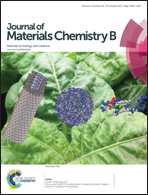Effectively promoting wound healing with cellulose/gelatin sponges constructed directly from a cellulose solution†
Abstract
Wound dressing is of critical importance for wound repair, and the traditional cotton gauze derived from cellulose has commonly been used in clinical practice for a long time. However, cotton gauze does not possess active healing ability. To search for new wound dressings, in this work, a cellulose sponge was fabricated directly from a cellulose solution in a NaOH/urea aqueous system with cooling, and then cellulose/gelatin composite sponges were constructed successfully via a green and cost-effective pathway. The structure and physical properties of the sponges were characterized, and their cytocompatibility and in vivo wound healing ability were evaluated. The results indicated that, compared with cotton gauze, the cellulose sponge effectively promoted wound healing, as a result of the presence of macro- and micro-porous architecture. Furthermore, gelatin and basic fibroblast growth factor (bFGF) were immobilized in the cellulose sponge through hydrogen bonding to retain their inherent biocompatibility, leading to excellent repairing efficacy. In particular, for the full-thickness cutaneous wound model, the complete wound healing time for the wounds treated with bFGF-loaded cellulose sponges was 7 days faster than those treated with gauze. The pores with thin walls in the cellulose composite sponges played an important role in achieving the highly effective wound healing, which could fit the requirements of oxygen permeability, controlled water vapor evaporation and wound exudate absorption.


 Please wait while we load your content...
Please wait while we load your content...